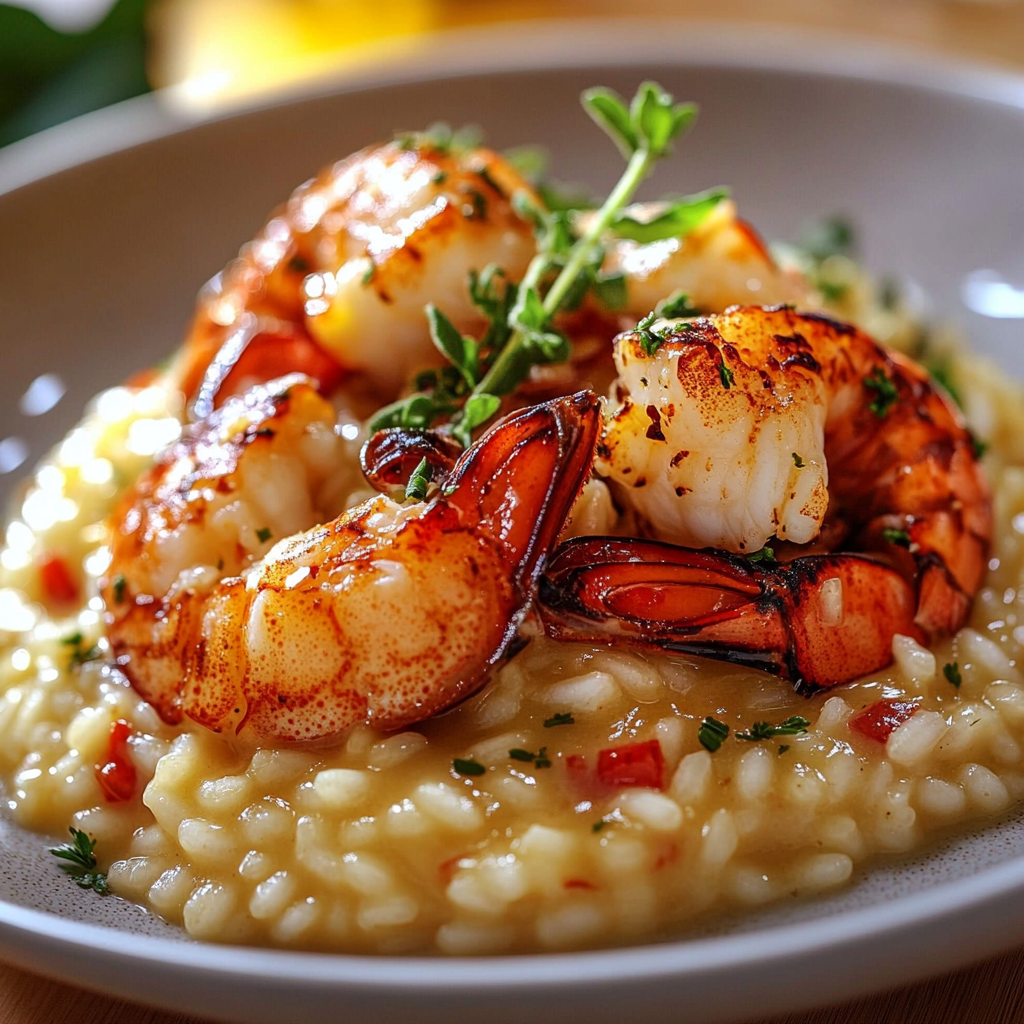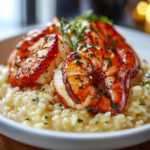Lobster risotto is a luxurious dish that brings the essence of fine dining right into your home kitchen. Imagine indulging in a creamy blend of Arborio rice cooked to perfection, infused with the rich flavors of succulent lobster meat, and finished with a drizzle of white wine and a sprinkle of fresh herbs. This delectable seafood risotto is not only comforting but also elegant enough to impress your guests on special occasions.

Preparing lobster risotto might seem daunting at first glance, but with the right ingredients and techniques, you can create a restaurant-quality meal that will leave everyone asking for seconds. The key to achieving the perfect texture lies in the slow-cooking method that allows the rice to absorb all the flavorful broth while maintaining its al dente bite.
In this comprehensive guide, we will cover everything from selecting the freshest ingredients to step-by-step instructions on how to prepare this delightful dish. You’ll also find tips on serving and storing leftover lobster risotto, ensuring that every aspect of your culinary experience is enjoyable. So roll up your sleeves and get ready to embark on a culinary adventure that will elevate your cooking skills and delight your taste buds!
Main Ingredients
Arborio Rice
Arborio rice is essential for making authentic lobster risotto due to its high starch content. This short-grain rice absorbs liquid beautifully while releasing starch during cooking, resulting in that signature creamy texture we all crave in a good risotto. For this recipe, you will need approximately 1 cup of Arborio rice which serves about 4 people.
Fresh Lobster
The star of our dish is undoubtedly the fresh lobster. You can use either whole lobsters or pre-cooked lobster meat; however, using live lobsters will yield a sweeter flavor and more tender meat. For this recipe, plan on using about 1 pound of fresh lobster meat after cooking and shelling.
Onion
A finely chopped onion adds depth and sweetness to your lobsters’ base flavor profile. Use one medium-sized yellow onion for this recipe. Sautéing it until translucent creates a fragrant base for your risotto.
Garlic
Garlic complements the sweet notes of lobster beautifully while enhancing the overall flavor without overwhelming it. Use three cloves of minced garlic for this recipe to elevate the taste without overpowering other ingredients.
Chicken or Seafood Broth
The broth you choose plays an important role in infusing flavor into your risotto. A rich chicken or seafood broth works perfectly here; aim for about 4 cups to ensure there’s enough liquid for cooking the rice gradually.
White Wine
Adding white wine gives a wonderful acidity that balances out the richness of the dish. Choose a dry white wine such as Sauvignon Blanc or Pinot Grigio; around ½ cup should suffice for deglazing and adding flavor.
Parmesan Cheese
To achieve creaminess without heavy cream, grated Parmesan cheese is added toward the end of cooking. About ½ cup will provide that rich flavor and silkiness you desire in every spoonful.
Fresh Herbs
Fresh herbs like parsley or chives are used as garnish before serving. Their bright flavors add freshness to each bite while making your plate visually appealing.

How to Prepare Lobster Risotto
Step 1: Cook the Lobster
Begin by bringing a large pot of salted water to boil over high heat. Once boiling, carefully add live lobsters (if using) headfirst into the pot. Cover immediately and cook for about 8-10 minutes until they turn bright red. Remove them from water and place them in an ice bath to cool down quickly—this stops further cooking and preserves tenderness. Once cooled, extract the meat from claws and tail; chop it into bite-sized pieces and set aside.
If you’re using pre-cooked lobster meat instead, skip this step but ensure it’s well-chilled before adding it later in your preparation process.
Step 2: Sauté Aromatics
In a large saucepan over medium heat, add about 2 tablespoons of olive oil along with your finely chopped onion. Sauté until translucent (about 5 minutes) before adding minced garlic; cook for another minute until fragrant but not browned—this helps maintain their sweet flavors without bitterness.
This aromatic base sets up an excellent foundation for building layers upon layers of flavor in our dish! Stir occasionally while monitoring heat levels so nothing sticks or burns at this stage.
Step 3: Toast Arborio Rice
Next comes adding Arborio rice directly into your pan! Stir it well into sautéed onions so each grain gets coated evenly with oil—a crucial step! Toasting should take no more than 2 minutes until lightly golden brown; this activates starches within grains improving texture later on as they absorb liquids beautifully during simmering processes ahead!
Once toasted adequately throughout time spent stirring consistently—add half a cup dry white wine we prepared earlier while scraping any browned bits off bottom surface (deglazing). Allow alcohol evaporate completely (around three minutes), leaving behind lovely acidity enhancing overall flavors present already!
Step 4: Gradual Addition Of Broth
Now begins our long journey towards creamy perfection! Slowly ladle hot broth into our mixture one cup at time ensuring consistent stirring between additions—this helps release more starch from grains giving us silky consistency desired when finished!
Keep doing this until you’ve used up all four cups total—approximately twenty minutes later! Taste regularly checking if al dente texture achieved (firm yet tender) before adding chopped cooked lobster pieces along remaining parmesan cheese last few minutes cooking ensuring everything melds together wonderfully creating harmony across plate presented beautifully when served!

Serving and Storing Tips
Serving Suggestions
When it comes time to serve your luscious lobster risotto masterpiece—presentation matters! Use shallow bowls instead deep plates allowing guests appreciate those beautiful textures colors showcased elegantly within each bowl served generously portioned out per guest attending occasion being hosted!
To finish off presentation sprinkle freshly chopped herbs (parsley/chives) atop each serving just prior bringing them out dining table—this adds visual appeal enhances aromas enticing diners even more! Pair with chilled dry white wine complementing seafood flavors present perfectly elevating entire experience enjoyed around dinner table shared together amongst loved ones celebrating special moments life brings forth capturing joy through delicious meals prepared lovingly enjoyed together.
Storing Leftovers
If you find yourself with leftovers after indulging fully—don’t fret! Store uneaten portions within airtight containers within refrigerator setting temperatures below forty degrees Fahrenheit ideally consuming within two days maximum keeping food safety standards maintained preventing spoilage occurring too soon post-preparation phase completed successfully earlier!
Reheating may require adding splash additional broth/water back into mixture reintroducing moisture lost through refrigeration process allowing creamy goodness return once again when reheated gently stove top medium-low heat stirring frequently ensuring even warming throughout before serving enjoyed again either alone or alongside sides favorite dishes pairing alongside perfectly accommodating palate preferences expressed by family friends alike gathering together reminiscing over fond memories created during time spent enjoying sumptuous meals crafted carefully crafted throughout experience shared around tables surrounded warmth laughter love found comfort food delights gifted endlessly through culinary arts pursued passionately embracing creativity flourishing boundlessly across kitchens everywhere today tomorrow always forevermore!
Mistakes to avoid
Not Using Fresh Ingredients
One of the biggest mistakes you can make when preparing lobster risotto is using frozen or inferior-quality seafood. Fresh lobster has a sweet, delicate flavor that frozen lobster simply cannot replicate. When shopping for ingredients, always choose fresh seafood from a reputable source. Look for lobsters that feel heavy for their size and have a clean ocean smell. If fresh lobster is unavailable, consider using high-quality frozen lobster as an alternative, but be sure to thaw it correctly before cooking.
Overcooking the Lobster
Overcooking can ruin your lobster risotto, making the lobster rubbery and tough. To prevent this, cook the lobster just until it’s opaque and slightly firm. Remember that lobster continues to cook after you remove it from heat due to residual heat. For optimal texture, add the cooked lobster to the risotto in the last few minutes of cooking, allowing it to warm through without overcooking.
Skipping the Broth
A common mistake in making lobster risotto is neglecting to prepare a flavorful broth. The broth enhances the dish’s depth and richness, making it more enjoyable. Instead of using plain water or low-quality stock, simmer shells from the lobster with aromatics like onion, garlic, and herbs in water to create a rich broth. This broth can elevate your dish significantly, ensuring each bite of risotto is packed with flavor.

Tips and tricks
Choose the Right Rice
Using the right type of rice is crucial for achieving creamy lobster risotto. Arborio rice is the preferred choice because its high starch content releases creaminess during cooking. Avoid long-grain rice varieties that do not provide the same texture. Rinsing rice before cooking may seem appealing but should be avoided since it washes away essential starches needed for creaminess.
Stirring Techniques
Consistent stirring plays an important role in developing the creamy texture of your risotto. As you add broth gradually, stir frequently but gently. This technique helps release starch from the rice while preventing it from sticking together or burning at the bottom of your pan. However, do not over-stir; this may break down the grains too much and result in a mushy texture.
Patience with Broth Addition
Adding broth too quickly can lead to unevenly cooked rice in your lobster risotto. Instead of dumping all your broth at once, add it gradually—about one ladle at a time—and wait until most of it absorbs before adding more. This method ensures each grain cooks evenly and absorbs maximum flavor from both the broth and added ingredients.
Suggestions for lobster risotto
Pair with White Wine
Pairing white wine with your lobster risotto can enhance its flavors beautifully. A dry white wine like Sauvignon Blanc or Pinot Grigio complements seafood dishes well without overpowering them. Use some of this wine in your cooking process by adding it after sautéing onions and before adding broth; this will impart acidity and brightness into your dish.
Top with Fresh Herbs
Fresh herbs can brighten up your lobster risotto remarkably well. Finishing your dish with chopped parsley or chives adds color and freshness that balances out the richness of cream and seafood flavors. Consider incorporating lemon zest for an extra zing that makes every bite refreshing.
Serve Immediately
Lobster risotto is best enjoyed fresh off the stove while it’s still warm and creamy. Allowing it to sit can lead to undesirable changes in texture as it cools down and thickens further. If you need to prepare ahead of time, consider keeping components separate until serving: cook the rice base early but hold off on adding butter or cheese until you’re ready to serve for optimal results.
FAQs for lobster risotto:
What is lobster risotto?
Lobster risotto is a creamy Italian dish made with Arborio rice, fresh lobster meat, and a rich seafood broth. This dish combines the al dente texture of the rice with the succulent taste of lobster, creating a luxurious meal perfect for special occasions or weeknight dinners. The preparation involves sautéing onions and garlic, adding the rice, and gradually incorporating broth while stirring constantly. The key to a perfect risotto is patience; this method allows the rice to release its starches, resulting in a creamy consistency. Fresh herbs like parsley or chives can enhance the flavor, while a squeeze of lemon adds brightness to balance the richness of the lobster.
How do I cook lobster for risotto?
Cooking lobster for your risotto can be done in several ways, but steaming or boiling are the most common. Start by bringing a large pot of salted water to a boil. Add live lobsters and cook them for about 8-12 minutes, depending on their size. Once cooked, remove them from the pot and let them cool before cracking open the shells to extract the meat. Alternatively, you can use pre-cooked lobster meat if you’re short on time. When preparing your risotto, fold in the cooked lobster pieces just before serving to retain their tenderness and flavor.
Can I use frozen lobster for risotto?
Yes, you can use frozen lobster for your lobster risotto without compromising taste or quality if you prepare it properly. Start by thawing frozen lobster overnight in the refrigerator or placing it in cold water for faster results. Once thawed, cook it as you would fresh lobster by boiling or steaming. Be cautious not to overcook it during reheating; you want it tender and succulent when added to your risotto. Using frozen lobster can also be more convenient and budget-friendly while still delivering delicious flavors in your dish.
What wine pairs well with lobster risotto?
A well-chosen wine can enhance your dining experience with lobster risotto significantly. A crisp white wine like Chardonnay or Sauvignon Blanc complements the rich flavors without overpowering them. If you prefer something bolder, an oaked Chardonnay provides an excellent balance between acidity and creaminess that mirrors the dish’s texture. Alternatively, a light Pinot Grigio works beautifully as it refreshes your palate between bites of rich risotto. Remember that serving your wine chilled enhances its flavors and makes for an enjoyable pairing.
How long does it take to make lobster risotto?
Making lobster risotto typically takes around 30 to 40 minutes from start to finish. The process begins with preparing ingredients such as onion, garlic, rice, broth, and cooked lobster meat. Sautéing aromatics usually takes about 5 minutes before adding rice and broth gradually over approximately 20-25 minutes until it reaches that creamy consistency. Folding in cooked lobster at the end requires just a few minutes before serving it hot. Although this dish requires attention while cooking, it’s relatively quick compared to other gourmet meals.
Can I make lobster risotto ahead of time?
While it’s best to serve freshly made lobster risotto due to its creamy texture and flavor profile, you can prepare some components ahead of time for convenience. Cooked shrimp or seafood broth can be stored in airtight containers in the refrigerator for up to three days prior to assembly. However, it’s advisable not to store finished risotto as it may lose its creamy texture upon reheating and could become mushy. Instead, prepare individual servings fresh when you’re ready to enjoy this exquisite dish.
Print
Lobster Risotto
- Total Time: 45 minutes
- Yield: Serves 4
Description
Indulge in the rich and creamy flavors of lobster risotto, the perfect dish for special occasions or a comforting weeknight dinner. This gourmet seafood recipe combines tender Arborio rice with succulent lobster meat, infused with aromatic garlic and onion, finished with a splash of white wine and a sprinkle of fresh herbs. With its elegant presentation and delightful taste, this dish is sure to impress your guests and elevate your culinary repertoire.
Ingredients
– 1 cup Arborio rice
– 1 pound fresh lobster meat (or pre-cooked)
– 1 medium yellow onion, finely chopped
– 3 cloves garlic, minced
– 4 cups chicken or seafood broth
– ½ cup dry white wine (Sauvignon Blanc or Pinot Grigio)
– ½ cup grated Parmesan cheese
– Fresh herbs (parsley or chives) for garnish
Instructions
1. Cook the lobster: Boil lobsters for 8-10 minutes. Cool in an ice bath, then extract meat.
2. Sauté aromatics: In a saucepan, heat olive oil, sauté onion until translucent; add garlic.
3. Toast rice: Stir in Arborio rice for 2 minutes until lightly golden.
4. Deglaze: Add white wine, cook until evaporated.
5. Gradually add broth: Stir in hot broth one cup at a time until absorbed and rice is creamy (about 20 minutes).
6. Finish: Fold in lobster meat and Parmesan cheese; serve garnished with fresh herbs.
Notes
– For extra flavor, consider making a lobster broth using shells and aromatics.
– Substitute lobster with shrimp or scallops for variations.
- Prep Time: 15 minutes
- Cook Time: 30 minutes
Nutrition
- Calories: 450
- Fat: 14g
- Carbohydrates: 60g
- Fiber: 2g
- Protein: 22g
In summary, making a delightful lobster risotto involves combining quality ingredients with careful preparation techniques that yield a creamy and flavorful dish. Start with fresh or frozen lobsters prepared through boiling or steaming methods before incorporating them into sautéed onions and Arborio rice mixed with rich seafood broth gradually stirred until creamy perfection is achieved.
The right wine selection can further elevate your dining experience while ensuring that each bite bursts with flavor from both the rice and succulent seafood elements present in every mouthful of this luxurious meal.
While making this dish requires some effort and attention during cooking time—approximately 30-40 minutes—the reward is well worth it as you savor each bite filled with buttery goodness from tender chunks of sweet lobsters nestled within velvety grains of perfectly cooked arborio rice topped off with fresh herbs! Enjoying homemade Lobster Risotto will surely impress guests or provide yourself an indulgent treat any day!


2 thoughts on “Lobster Risotto”